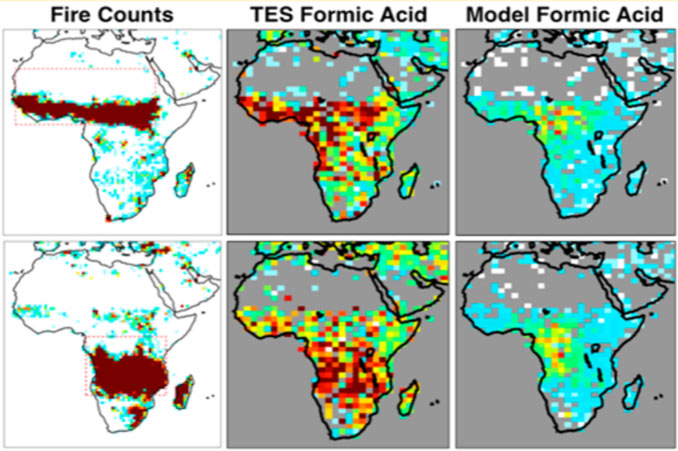Science
A Large Underestimate of Formic Acid from Tropical Fires

When it comes to determining the amount of formic acid (HCOOH) in our atmosphere, it seems like a global game of smoke and mirrors. We can measure it but we don’t know exactly where it comes from. This is a little troubling, because the gap between the known amount of HCOOH and its proven sources is significant. The scientists working with data from NASA’s Aura Tropospheric Emissions Spectrometer (TES) want to peel back the layers and enhance our current understanding.
Resolving this mystery has driven TES scientists to observe fires and fire plumes, especially over tropical Africa. Like a virtual Daniel bravely going into the lion’s den, TES probed the inner workings of large biomass burns. Satellite measurements can provide unique constraints by providing a high level, integrated picture of the total HCOOH produced by a given fire. Although TES data was gathered from NASA’s Aura satellite, it was evaluated using aircraft observations and other customized models and algorithms.
HCOOH is one of the most abundant carboxylic acids and a dominant source of atmospheric acidity. Studies show that a substantial fraction of reactive carbon from fires goes through HCOOH during its oxidation process. TES has been attempting to isolate and quantify this important chemical.
The results revealed something fascinating about fires -- they change as they age. Chemical reactions don’t just occur directly from the flames, fire plumes and the chemicals in them are evolving over time. This argues for substantial and rapid secondary production of HCOOH from fire production.
Armed with enhanced knowledge about the missing quantity of HCOOH from fires, scientists can turn their attention elsewhere. Data suggest a convolution of sources that all contribute to HCOOH ultimate yield—direct emission, photochemical production, depositional and chemical losses and non-fire sources. The quest to reveal where the substantial quantities of formic acid and other compounds harmful to our atmosphere continues.
Citation: Chaliyakunnel, S., D. B. Millet, K. C. Wells, K. E. Cady-Pereira, and M. W. Shephard, A Large Underestimate of Formic Acid from Tropical Fires: Constraints from Space-Borne Measurements, Environ. Sci. Technol., 50 (11), 5631–5640, https://dx.doi.org/doi:10.1021/acs.est.5b06385, 2016.
Mission Highlights
Swipe to view more highlights
Loading mission highlights...